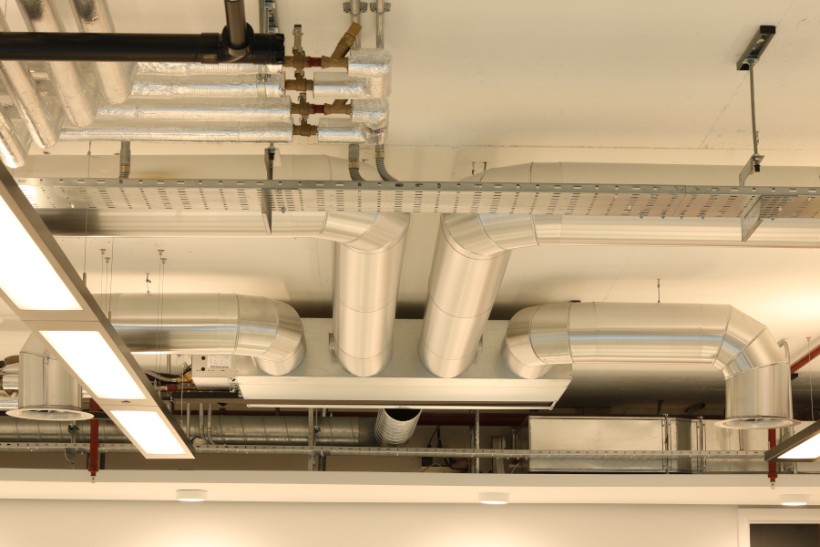What are the different types of fan coil units?
Contents |
[edit] Introduction
There are four types of fan coil units (FCUs): horizontal chassis above a ceiling void, horizontal exposed, underfloor and vertical wall mounted units. All options offer a similar level of performance and can deliver heating and cooling, heating only and cooling only, so specification generally comes down to the design requirements and ensuring the building’s demands are met.
[edit] Horizontal above a ceiling void fan coils
Ideal for new build developments or as a retrofit option where the units need to (or can be) concealed in the ceiling void. Fan coils in this type of installation can work slightly harder per unit as acoustics are buffered by the ceiling and any other insulating layers reducing noise levels in space below.
[edit] Horizontal exposed fan coils
Popular as part of an industrial inspired design within offices, restaurants or reception areas. Exposed fan coil design revolves around how the units look and the requirements for installation to align with the aesthetics of interior spaces. Another consideration when exposing fan coils is acoustics. As there is no longer something to insulate any noise produced, you may need to specify larger units working at a lower rate or utilising attenuators to meet the required demands to ensure limited disruption to occupants.
[edit] Underfloor fan coils
A perimeter solution used in conjunction with displacement ventilation system to combat drafts and solar gains from glazed facades or curtain walls. Underfloor fan coils also allow greater floor to ceiling heights for more spacious designs.
All buildings have a raised floor/false floor so submerging those units and then it means that there is the less
[edit] Wall mounted fan coils
Ideal for refurbishments where low ceiling heights limit installation within the void, in which case a vertical unit can either be mounted within a false wall or cabinet, using a chassis type or can be supplied with a case. The units can be mounted either at low level or high on the wall.
Fan coil units offer a dynamic and discreet solution to meet demands in all types of applications and development, providing a comfortable indoor environment for occupants. They can be controlled centrally or on a room by room basis and, in some instances, manufacturers will offer controls that can manage temperature for multiple rooms in a single unit.
For more information on the fan coils solutions and unique controls offered by GDHV or to discuss a specific project in more detail, please contact our team of experts. GDHV also have a comprehensive range of CIBSE accredited CPDs offering advice on fan coils and heat pumps, contact us to book a seminar, or join in the conversation on our LinkedIn page.
--Glen Dimplex Heating & Ventilation, 13:05, 31 Mar 2021 (BST)
[edit] Related articles on Designing Buildings Wiki
Featured articles and news
RTPI leader to become new CIOB Chief Executive Officer
Dr Victoria Hills MRTPI, FICE to take over after Caroline Gumble’s departure.
Social and affordable housing, a long term plan for delivery
The “Delivering a Decade of Renewal for Social and Affordable Housing” strategy sets out future path.
A change to adoptive architecture
Effects of global weather warming on architectural detailing, material choice and human interaction.
The proposed publicly owned and backed subsidiary of Homes England, to facilitate new homes.
How big is the problem and what can we do to mitigate the effects?
Overheating guidance and tools for building designers
A number of cool guides to help with the heat.
The UK's Modern Industrial Strategy: A 10 year plan
Previous consultation criticism, current key elements and general support with some persisting reservations.
Building Safety Regulator reforms
New roles, new staff and a new fast track service pave the way for a single construction regulator.
Architectural Technologist CPDs and Communications
CIAT CPD… and how you can do it!
Cooling centres and cool spaces
Managing extreme heat in cities by directing the public to places for heat stress relief and water sources.
Winter gardens: A brief history and warm variations
Extending the season with glass in different forms and terms.
Restoring Great Yarmouth's Winter Gardens
Transforming one of the least sustainable constructions imaginable.
Construction Skills Mission Board launch sector drive
Newly formed government and industry collaboration set strategy for recruiting an additional 100,000 construction workers a year.
New Architects Code comes into effect in September 2025
ARB Architects Code of Conduct and Practice available with ongoing consultation regarding guidance.
Welsh Skills Body (Medr) launches ambitious plan
The new skills body brings together funding and regulation of tertiary education and research for the devolved nation.
Paul Gandy FCIOB announced as next CIOB President
Former Tilbury Douglas CEO takes helm.
UK Infrastructure: A 10 Year Strategy. In brief with reactions
With the National Infrastructure and Service Transformation Authority (NISTA).

























